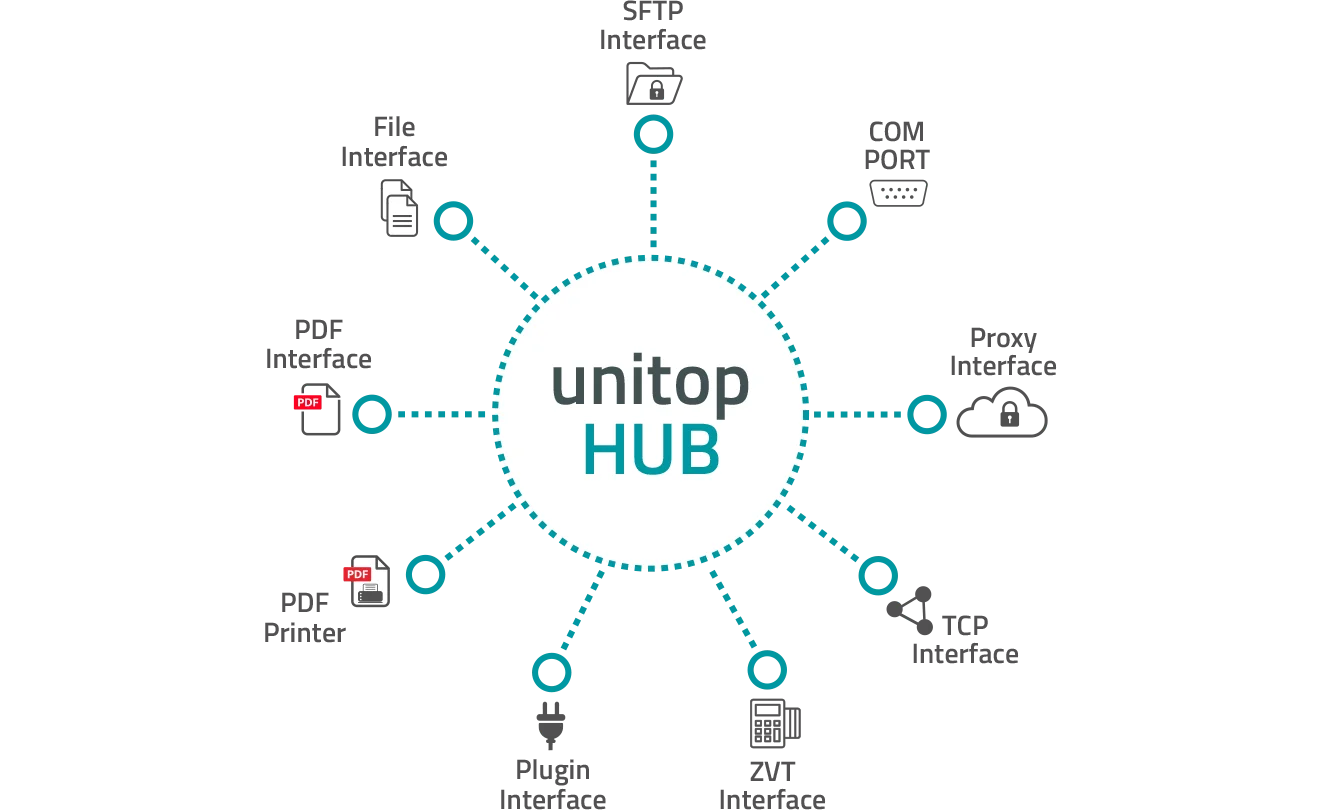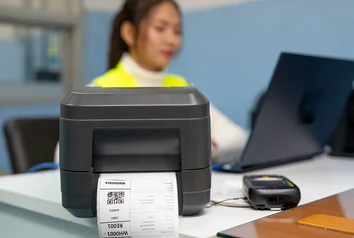
Whether you’re using the local periphery, distributed systems or cloud applications, the unitop Hub allows you to create a secure, central bridge between your existing IT infrastructure and your ERP solution – whether they are operated locally or in the cloud. The hub was designed to be seamlessly integrated within your system landscape and display a huge variety of technical interfaces in a uniform way.
Flexible. Carefully thought-out. Expandable
unitop Hub – the smart hub for your IT
The unitop Hub is the smart interface between your local IT and unitop. It is also scalable and controllable and can be used wherever it is needed. A reliable switch at all times, it links your systems, devices and applications together and can be adjusted to suit your requirements by activating individual functions in a targeted way. Whether you use it for file sharing, controlling devices or processing PDFs, the unitop Hub makes integration efficient, controllable and future-proof. What exactly can the unitop Hub do? Here are its most important functions:

Files are securely shared between unitop, local directories and SFTP services via the file interface and the SFTP interface to ensure seamless processes without media discontinuities.
Whether you are using a parcel scale, warehouse shelf or card reader, the unitop Hub reliably links connected devices together, directly from your ERP system, via TCP, COM and ZVT interfaces.
The PDF interface places useful tools at your disposal: PDF files can be split, merged, converted (to PDF/A format, for example) or password-protected. To obtain a conventional print-out, an integrated PDF-printing service is also included.
Internally available web services can be reached securely via the proxy. This enables protected services to be incorporated into ERP processes too, without any gaps in security.
Thanks to the open architecture, the unitop Hub can be expanded using individual add-ons. Using the plug-in interface, we can integrate additional functions in line with your requirements (such as SQL queries or additional data sources) without any problem.
Flexible. Versatile. Big on connectivity. The unitop Hub
One interface, many possibilities
As a smart hub between the ERP system and the real-life world of work, unitop Hub can be integrated into a wide range of processes and sectors.
Whether as a digital bridge in manufacturing, as a switch to control hardware or as a connection to local data pathways, the unitop Hub can be used in many different ways and seamlessly integrates itself into a wide variety of sector-specific processes. The digital interface allows you to securely access devices and services directly from your ERP – local, cloud-based or hybrid.
Below, we have included some potential use cases to show you how the digital interface enables the ERP system to communicate with local infrastructure.
In the goods outward department, every detail counts. The unitop Hub ensures that dispatch labels, invoices or delivery waybills are sent directly to local or network printers from the ERP system – without passing through any additional interfaces along the way. That way, logistics and commercial companies can retain an overview and speed up the dispatch process even more.
Whether in logistics, production or variant manufacturing, if the ERP system needs to communicate with weighing machines, scanners or measurement devices, the unitop Hub controls access to COM ports or USB connections. That way, measurement results and scans are transmitted directly into the system – quickly, traceably and error-free.
Industrial companies often use machinery controlled via serial interfaces, (e.g. RS232). The unitop Hub creates the connection via the COM port protocols and enables specialist hardware to be controlled directly from the ERP system. No reprogramming or external tools are required.
In the retail sector, in academies or at not-for-profit or charitable events: if a customer pays directly on a card terminal, the unitop Hub ensures seamless communication between the POS deviceand the ERP. Using the ZVT interface, you can transmit amounts, receive status messages and log payments directly in your accounting system.
In technical sales, NPOs or planning departments, your staff can upload CAD drawings, lists of donations or CSV files into the ERP or save automatically generated PDFs locally. The unitop Hub forms the bridge to local directories and makes sure that data exchange remains secure, without media discontinuities or any interim manual steps being needed.
Many organisations use web services that were developed internally. For security reasons, these often cannot be accessed externally. Examples of these include data interrogation, audit logging and internal communication applications. In those cases, the unitop Hub takes on the role of a secure proxy server and enables targeted access to these services directly from the ERP system.
Innovating. Transforming. Succeeding.
Connected locally or via Azure Relay – the decision is yours
The unitop Hub can be connected using two technologies. It can either be used in conventional on-prem mode or can be activated securely via a Microsoft Azure Relay, to protect communication with your SaaS-based unitop solution, without any data leaving the internal network.
Thanks to its scalable architecture, the unitop Hub flexibly adapts to your infrastructure. Not only can it be expanded to include additional functions, but it can also be operated in multiple dedicated instances. This is especially practical if different, separate networks need to be connected to it.
The unitop Hub also scores in terms of security. Specific interfaces that are not required can be deactivated so that only the connections that are in use remain active. The data, however, remain on the internal network at all times. That way, you are fully in control the entire time.

Why Microsoft Azure Relay?
The Microsoft Azure Relay service provides a secure connection from outside to services located inside a protected network – without opening ports or needing a lengthy VPN configuration. The unitop Hub uses this technology so that it can be accessed reliably in cloud or SaaS scenarios, without any internal data being transferred to the cloud. Your data remain where they belong – on your protected internal network.
Benefits



